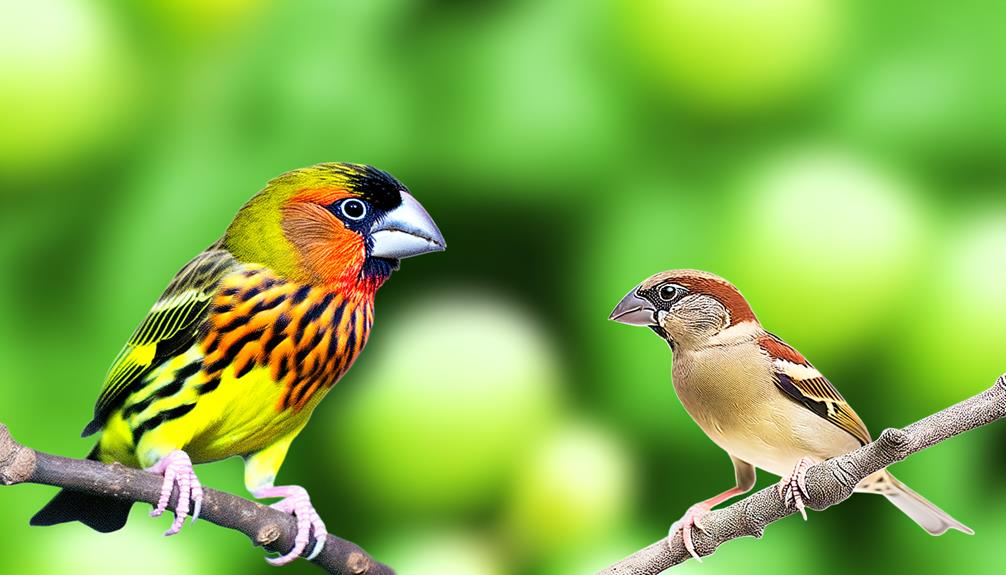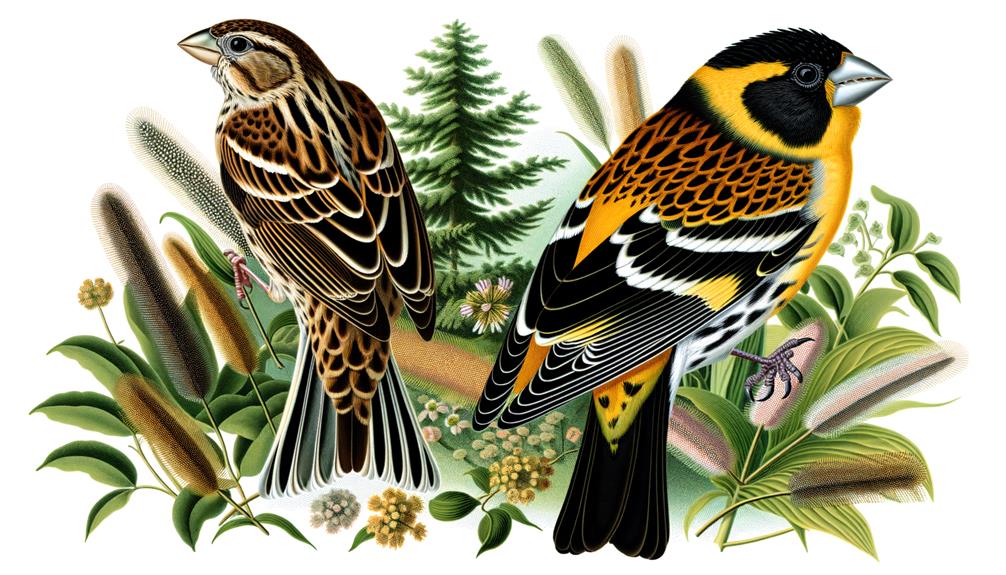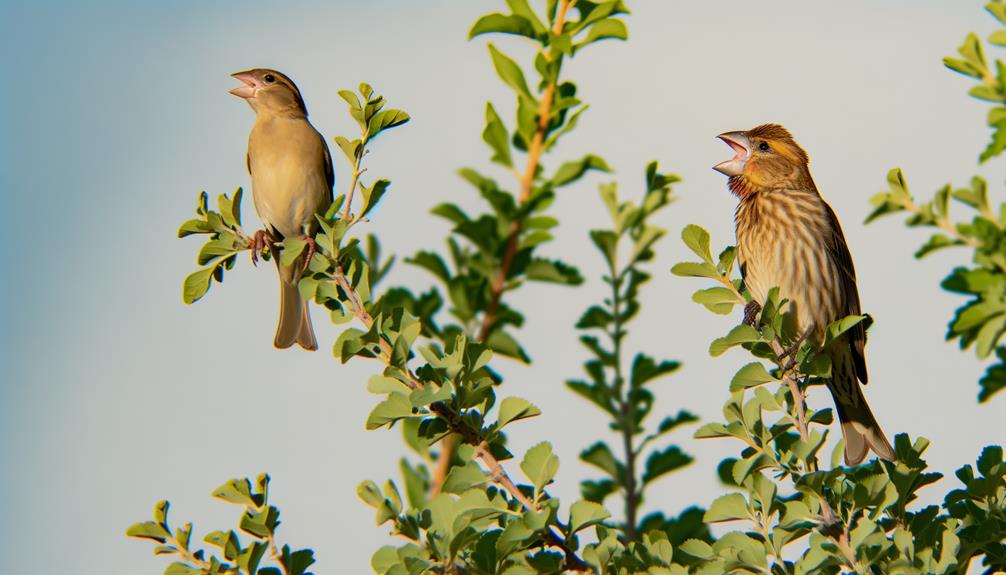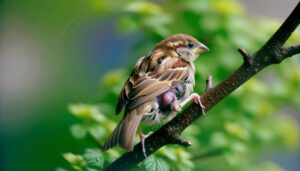5 Key Differences Between Female Grosbeaks and Sparrows
When identifying female grosbeaks and sparrows, you'll observe several key differences. Female grosbeaks have a larger, more robust body with a stout, conical bill designed for cracking seeds.
Their wing and tail patterns are bold with bright white bars and contrasting colors. Conversely, female sparrows have a smaller, streamlined body with a finer, pointed bill suitable for a diverse diet.
Their wing and tail patterns are more subtle, featuring muted brown tones. Grosbeaks prefer forested habitats, while sparrows thrive in open fields.
Their vocalizations also differ, with grosbeaks having complex melodies and sparrows using simple, repetitive calls. To explore further nuances, you can…

Key Takeaways
- Female grosbeaks have robust bodies and large, conical bills, while female sparrows are slender with finer, pointed bills.
- Grosbeaks exhibit bold white wing bars and vibrant tail feather colors, whereas sparrows have more subtle or absent wing markings.
- Grosbeaks prefer forested areas, while sparrows are commonly found in open fields and grassy habitats.
- Female grosbeaks sing complex, melodic songs; female sparrows use simple, repetitive calls.
- Grosbeaks mainly eat seeds and fruits, using their strong beaks, while sparrows have a varied diet including seeds, insects, and invertebrates.
Size and Body Shape

When comparing the female grosbeak and sparrow, you'll observe that the grosbeak generally has a larger and more robust body shape, whereas the sparrow is more petite and slender.
The grosbeak's body length typically ranges from 18-21 cm, with a wingspan extending up to 35 cm. In contrast, the sparrow's length averages 14-16 cm, and its wingspan is about 20-25 cm.
The grosbeak's broader chest and stronger muscular build allow for more powerful flight and foraging capabilities. Meanwhile, the sparrow's streamlined form provides agility and speed, suitable for quick escapes from predators.
Notice how the difference in body mass influences their behavior; grosbeaks are often observed in stable perches, while sparrows flit energetically through foliage.
Bill Characteristics
Observing their bill characteristics, you'll notice the female grosbeak's bill is stout and conical, perfectly adapted for cracking seeds, while the sparrow's bill is finer and more pointed, suited for a diet that includes both seeds and insects.
The grosbeak's robust bill allows it to exert significant pressure, efficiently breaking open hard seed shells. In contrast, the sparrow's slender bill provides dexterity and precision, enabling it to pick small seeds and catch insects with ease.
This distinction is essential for their respective feeding strategies; the grosbeak relies heavily on its bill's strength, whereas the sparrow benefits from versatility. Understanding these differences helps in identifying and appreciating their unique adaptations, enhancing your ability to support their ecological needs.
Wing and Tail Patterns

You'll notice female grosbeaks typically exhibit prominent, well-defined wing bars, whereas sparrows often have more subtle or absent wing markings.
Tail feather colors in female grosbeaks tend to be more varied and can include contrasting shades, unlike the generally uniform brown tones seen in sparrows.
Additionally, the pattern consistency in grosbeaks is more pronounced and identifiable compared to the often irregular and muted patterns in sparrows.
Distinct Wing Bars
Distinct wing bars are a key characteristic that helps differentiate female grosbeaks from sparrows, with grosbeaks displaying more pronounced and contrasting patterns on their wings and tails. When you observe a female grosbeak, you'll notice the bold, white wing bars set against darker feathers. In contrast, sparrows have subtler, less distinct wing bars that blend more seamlessly into their overall plumage.
Here's a comparative table to highlight these differences:
| Feature | Female Grosbeak | Female Sparrow |
|---|---|---|
| Wing Bar Contrast | High | Low |
| Color of Wing Bars | Bright White | Pale or Buff |
| Overall Wing Pattern | Distinct and Bold | Subtle and Blended |
| Tail Pattern | Striking | Modest |
| Observation Ease | Easy to Identify | Requires Closer Look |
Tail Feather Colors
When examining tail feather colors, you'll find that female grosbeaks exhibit a more vibrant and contrasting palette compared to the more muted and uniform tones of female sparrows. Grosbeaks often display tail feathers with rich browns and striking white tips, creating a visually distinct pattern.
In contrast, female sparrows typically have tail feathers in shades of brown and gray, blending seamlessly with their overall plumage. The grosbeak's tail feathers also show pronounced markings, such as darker central stripes, which aid in species identification.
Observing these differences allows you to better appreciate the intricate beauty of each bird and enhances your ability to serve others by sharing accurate, detailed information about these fascinating species.
Pattern Consistency
Examining the wing and tail patterns reveals that female grosbeaks exhibit more consistent and strikingly contrasted markings than their sparrow counterparts.
You'll notice that the grosbeak's wing feathers display bold, well-defined bars, while sparrows often have more mottled and less distinct patterns.
Additionally, the tail feathers of grosbeaks tend to have more uniform coloration with sharp edges.
Here's a quick comparison:
- Wing Bars: Female grosbeaks have prominent, clear wing bars. Sparrows' wing bars are generally less defined.
- Tail Feathers: Grosbeaks' tails are uniformly colored with sharp edges. Sparrows show more variation and diffuse edges.
- Overall Pattern: Grosbeaks maintain consistent patterns across individuals, while sparrows exhibit more variability.
This detailed comparison helps you better identify and understand these birds.
Plumage Coloration
When examining plumage coloration, you'll notice that female grosbeaks exhibit more muted, brownish hues with subtle streaking compared to sparrows, which often display more varied brown and gray patterns.
Seasonal color changes are prominent in grosbeaks as they molt into brighter plumage during breeding season, while sparrows exhibit less drastic seasonal variation.
Juvenile plumage differences are also significant, with young grosbeaks resembling adult females, whereas juvenile sparrows can show distinct streaking and lighter coloration.
Color Patterns Observed
Sporting distinct plumage, female grosbeaks exhibit a combination of earthy browns and creamy streaks, while female sparrows typically display more uniform brown and gray tones.
You'll notice that female grosbeaks have:
- Bold streaking on their breasts and flanks, enhancing their camouflage in wooded areas.
- Distinctive facial markings, often with a pale eyebrow stripe and contrasting cheek patches.
- Wing bars that are more pronounced, providing an additional visual identifier.
In contrast, female sparrows present a more subdued and uniform appearance:
- Subtle streaking that blends seamlessly into their overall coloration.
- Less pronounced facial patterns, making them harder to distinguish.
- Minimal wing bar contrast, adding to their muted look.
Seasonal Color Changes
As you observe throughout the year, female grosbeaks and sparrows undergo notable seasonal color changes, adapting their plumage to shifting environmental conditions. Female grosbeaks exhibit more pronounced changes; during breeding season, their feathers often become brighter, showcasing subtle yellows and greens to attract mates.
Conversely, in non-breeding months, their plumage adopts a more muted, camouflaged appearance for protection. Sparrows, while also experiencing seasonal shifts, display less dramatic changes. Their coloration remains relatively consistent, though slight darkening or lightening of browns and grays occurs in response to seasonal demands.
Juvenile Plumage Differences
Juvenile grosbeaks and sparrows exhibit distinct plumage differences, with juvenile grosbeaks often showing streaky brown and white feathers, while juvenile sparrows typically display more uniform brown and gray tones.
When observing these birds, you'll notice:
- Pattern Variations: Juvenile grosbeaks have more pronounced streak patterns, aiding in camouflage among foliage, whereas sparrows have subtler, more consistent coloration.
- Feather Texture: Grosbeaks exhibit a mix of coarse and fine feather types, allowing for better temperature regulation. Sparrows, in contrast, have uniformly fine feathers.
- Color Intensity: Grosbeak juveniles display higher contrast between their dark streaks and pale underbellies, while sparrows maintain a muted, even coloration.
These differences not only aid in identification but also serve distinct ecological roles, enhancing your ability to support conservation efforts.
Habitat Preferences

Female grosbeaks and sparrows exhibit distinct habitat preferences. Grosbeaks favor forested areas and woodland edges, often near water sources. They thrive in deciduous and mixed woodlands, benefiting from dense foliage that offers ample nesting sites and protection.
Sparrows, on the other hand, are more commonly found in open fields and grassy habitats. They prefer environments such as meadows and farmlands, where they can take advantage of unobstructed views and abundant ground cover for nesting. This divergence in habitat selection is key to their survival strategies, influencing their behavior and interactions.
Understanding these differences is crucial for creating supportive environments tailored to each species' natural tendencies. By enhancing their well-being through suitable habitats, we can promote biodiversity and contribute to the conservation of these bird species.
Feeding Habits
How do the feeding habits of female grosbeaks and sparrows differ, given the distinct ecological niches they occupy?
Female grosbeaks prefer seeds and fruits, leveraging their strong beaks to crack open tough shells. Conversely, sparrows exhibit more varied diets, often consuming seeds, insects, and small invertebrates.
You'll notice these differences in their feeding strategies:
- Grosbeaks: Their robust beaks are designed for breaking into hard seeds.
- Sparrows: They're more opportunistic, foraging on the ground for diverse food sources.
- Seasonal Adaptations: Grosbeaks might shift to fruit during breeding seasons, while sparrows increase insect intake to feed their young.
Understanding these habits offers insight into their ecological roles and how you can better support their needs in your environment.
Vocalizations and Calls

While their feeding habits highlight their ecological roles, their vocalizations and calls offer further insights into their behavioral adaptations and communication strategies. Female grosbeaks exhibit complex song structures, often used for mate attraction and territory defense. In contrast, female sparrows typically produce simpler calls primarily for social cohesion and alert signals.
| Species | Vocal Complexity |
|---|---|
| Female Grosbeak | Complex, melodic songs |
| Female Sparrow | Simple, repetitive calls |
| Species | Primary Vocal Function |
| Female Grosbeak | Mate attraction, defense |
| Female Sparrow | Social cohesion, alerts |
Your keen observation and understanding of these vocalizations can enhance conservation efforts and birdwatching experiences, allowing you to serve the avian community more effectively.
Conclusion
To sum up, you'll find that distinguishing female grosbeaks from sparrows involves more than meets the eye. By considering nuances like size, bill morphology, and wing patterns, you can decode their identities.
Their muted plumage and distinct habitats further set them apart, while their feeding habits and vocalizations add layers to their profiles.
So next time you're birdwatching, remember these subtle cues and you'll effortlessly navigate the avian world with a discerning eye.






